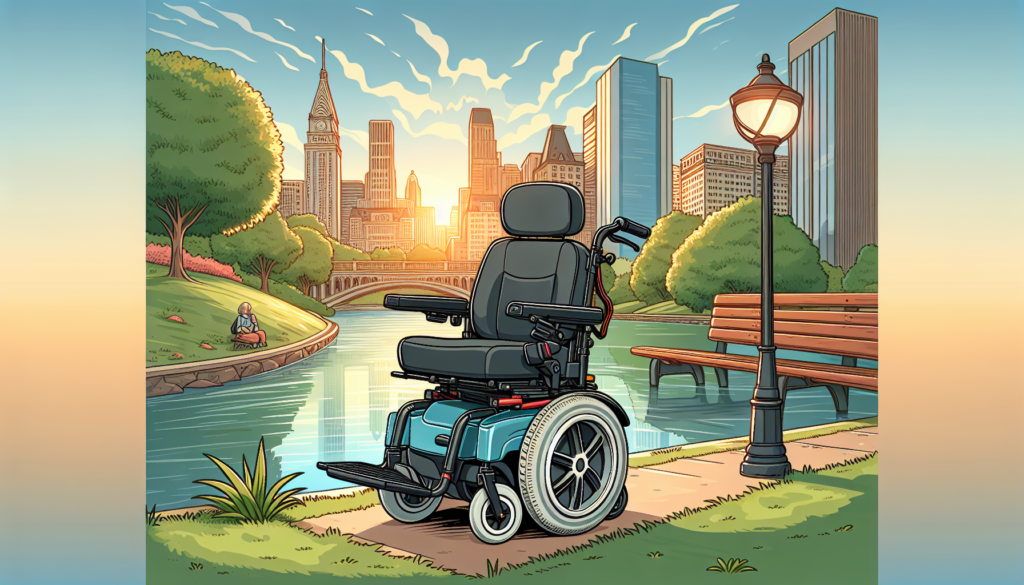
When it comes to mobility solutions, the debate between electric wheelchairs and regular wheelchairs is an important one, especially for individuals seeking independence and ease of movement. Electric wheelchairs have gained popularity for their enhanced features and capabilities, making them a smart investment for those who require consistent mobility assistance. With varying models available, such as the Edegree EW6 and the Stonbike TU-04b from EKO Life MY, potential buyers can choose an electric wheelchair that caters to their specific needs, from range per charge to climbing ability. Understanding the advantages of electric wheelchairs over regular models can help individuals make informed choices that can significantly improve their quality of life.
Understanding Electric Wheelchairs: Features and Benefits
Electric wheelchairs, also known as power chairs, are specifically designed to enhance mobility and independence for users with limited strength or mobility issues. These advanced mobility aids are electrically-powered, allowing for greater ease of movement compared to traditional manual wheelchairs. One of the standout features of electric wheelchairs is their ability to cover greater distances on a single charge, such as the Edegree EW1, which offers a range of up to 20 km, and the Stonbike TU-04 that can reach up to 25 km. This extended range allows users to navigate larger spaces effortlessly without the fatigue that can come with manual operation.
Moreover, electric wheelchairs are equipped with various speed settings and user-friendly controls, making them adaptable for diverse terrains and environments. Additionally, models like Edegree EW6 with a maximum forward speed of 8 km/h provide swift yet safe mobility, which is a significant advantage over standard wheelchairs. Beyond basic mobility, electric wheelchairs offer numerous benefits for day-to-day use. They feature advanced incline abilities, such as the Stonbike TU-04’s capability to climb 25° inclines, which is essential for accessing various locations without additional help.
The dual motor systems in these electric models, like the Edegree EW1 and EW6, ensure stability and power, providing confidence when traversing slopes or uneven surfaces. With a weight capacity of up to 150 kg in certain models, users can carry essential items comfortably. By investing in an electric wheelchair, not only do users gain enhanced mobility, but they also gain a sense of autonomy and independence, making them a smart and worthwhile purchase in the long run.
Comparing Speed and Mobility: Electric vs. Regular Wheelchairs
Besides speed, electric wheelchairs offer enhanced climbing capabilities compared to their manual counterparts. For example, the Edegree EW1 can handle inclines of 13°, while the Stonbike TU-04 can conquer slopes of up to 25°. This climbing ability is essential for users who live in hilly areas or require assistance navigating different terrains, as it eliminates reliance on others for assistance, promotes independence, and enhances overall access to various environments.
Furthermore, electric wheelchairs often feature dual motors and adjustable speed modes, providing the user with better control and adaptability to various situations. Overall, the combination of improved speed, climbing ability, and autonomy found in electric wheelchairs makes them a worthwhile investment compared to traditional models, ultimately translating into a more fulfilling lifestyle for the user.
Range and Battery Life: What You Need to Know
When considering an electric wheelchair, one of the most crucial factors is its range and battery life. Electric wheelchairs, like the Edegree EW6, offer a range of 10-15 km on a single charge, backed by a robust lithium battery. This provides users with the flexibility and freedom to navigate various distances without the stress of frequently recharging. In contrast, traditional manual wheelchairs require more physical effort for long distances, which may not be feasible for all users.
Knowing that models like the Stonbike TU-04 extend this range up to 25 km showcases the convenience that electric options provide, making them an ideal choice for those looking to maintain independence in their mobility choices. Battery performance plays a key role in the convenience of electric wheelchairs. For example, while the Edegree EW1 utilizes a lead-acid battery with a charging time of 6 hours, the Stonbike TU-04 gets significantly faster charging times of 3-5 hours thanks to its lithium battery, allowing for less downtime between uses.
Electric wheelchairs are designed to carry varying weights – with models like the EW6 and EW1 supporting up to 100 kg, and the Stonbike TU-04 enabling a max load of 150 kg – catering to a wide range of users. Overall, these advancements in range and battery technology emphasize the practicality and increased quality of life that electric wheelchairs can offer compared to traditional manual models.
Climbing Ability: Navigating Different Terrains
One of the significant advantages of electric wheelchairs over regular models is their climbing ability, which greatly enhances mobility across various terrains. For instance, models like the Stonbike TU-04 can tackle gradients of up to 25° degrees, allowing users to navigate hilly or uneven surfaces with ease. This capability makes electric wheelchairs an invaluable resource for individuals seeking independence while enjoying outdoor activities or simply moving around their homes where the terrain may not be flat. In comparison, traditional manual wheelchairs often struggle with inclines, which can limit access to essential places and activities for users.
Additionally, electric wheelchairs such as the Edegree EW1 and EW6 provide tailored gearing options with their 5-speed modes, accommodating different climbing needs. While the EW1 can handle a 13° incline and the EW6 climbs at less than 10°, both models maintain manageable forward and reverse speeds, making them versatile in diverse landscapes. This ability not only empowers users but also adds a layer of accessibility that regular wheelchairs lack. By investing in an electric wheelchair, users gain greater freedom and confidence to explore their surroundings, making it a smart investment for improved quality of life.
Weight Considerations: How Much Does It Matter?

Weight is a crucial factor to consider when evaluating electric wheelchairs, as it impacts both maneuverability and transportation ease. Electric wheelchairs, like the Edegree EW6, weigh 14.8 kg with the battery included, making it manageable for users seeking portability. In contrast, heavier models like the Edegree EW1 and Stonbike TU-04 can weigh 38 kg and 28 kg respectively, which can make them challenging to transport, especially for those needing assistance.
The lighter design of the Edegree EW6 is not only beneficial for users but also easier to lift into vehicles, enhancing independence for users who rely on caregivers or family members for travel support. Furthermore, the maximum load capacity of each model is significantly relevant, ensuring users can comfortably and safely utilize the mobility aid without compromising performance.
The importance of weight extends beyond just the physical aspect of the wheelchair. A lighter electric wheelchair can translate into a more effective and enjoyable riding experience, allowing users to navigate different environments with ease. Electric wheelchairs with lower weights can also contribute to better battery performance, as less weight can equate to increased range per charge. For instance, the Edegree EW1 provides a solid 20 km range, but its heavier construction may lead to heightened fatigue for both the user and anyone assisting with its transport. Recognizing these weight considerations when investing in an electric wheelchair is essential, as it can significantly impact the user’s everyday life and overall satisfaction with their mobility solution.
Cost Analysis: Are Electric Wheelchairs Worth the Investment?
When considering the purchase of a wheelchair, cost is often one of the primary factors that come into play. Electric wheelchairs, while generally more expensive upfront than regular wheelchairs, offer invaluable benefits that can justify their initial investment. For instance, models like the Edegree EW1 and Stonbike TU-04 have prices ranging from RM 2,499 to RM 3,600, and they provide a greater range, speed, and climbing ability, making them not only adequate for daily activities but also for outdoor use.
The ability to travel longer distances—like the Stonbike with a range of 25km—means users can maintain their independence and enjoy mobility without the physical strain that comes with self-propelling a traditional wheelchair. As a result, electric wheelchairs can significantly enhance quality of life for users who may struggle with physical exertion, making them a worthy financial commitment.
Furthermore, the longevity and low maintenance costs associated with electric wheelchairs contribute to their overall value. Although they require a higher initial expenditure, the technology in models such as the Edegree EW6, equipped with a powerful dual motor, often ensures durability and a long service life, reducing the need for frequent replacements or repairs. In addition, innovations like lithium batteries allow for faster charging times and extended ranges, providing more efficiency in daily use than lead-acid alternatives. When weighing these factors, the benefits of an electric wheelchair not only enhance the user’s mobility but can also make them a financially sound choice when considered over time.
User Experience: Real Stories of Electric Wheelchair Owners
Many electric wheelchair users report significant improvements in their daily experiences compared to traditional wheelchairs. For instance, individuals with limited upper body strength find electric wheelchairs, such as the Edegree EW6 and Edegree EW1, empower them to navigate their surroundings with ease and control. The dual motors and adjustable speed settings enhance their mobility, allowing them to tackle varying terrains and slopes effortlessly. Moreover, the freedom of movement without the constant need for pushing or assistance gives users a newfound sense of independence, drastically improving their quality of life.
Users frequently mention how electric wheelchairs have reduced physical strain during long outings. The Edegree EW1, for instance, offers an impressive range of up to 20 kilometers per charge, letting users travel greater distances without fatigue. Meanwhile, the Stonbike TU-04 provides enhanced weight capacity and robust climbing ability, catering to those who require a little more from their mobility device. These real-life stories reflect the positive impact of electric wheelchairs, showcasing how they not only meet functional needs but also foster emotional and social connections through increased accessibility and independence.
Making the Smart Choice: Why Electric Wheelchairs Are a Worthy Investment

In summary, electric wheelchairs offer enhanced mobility, comfort, and independence that is often unmatched by regular models. With options like the Edegree EW6 and EW1, or the Stonbike TU-04, individuals can find a suitable design that meets their specific needs. The range, speed, and climbing ability provided by electric wheelchairs allow users to navigate various terrains effortlessly, while their efficient battery systems and reasonable charging times ensure they remain operational when needed most. Coupled with durability and robust features, electric variations represent a significant upgrade in terms of functionality and user experience.
Moreover, investing in an electric wheelchair is not just about immediate comfort; it’s about considering long-term wellness and mobility. Such wheelchairs promote a more active lifestyle, encouraging independence and reducing the strain associated with manual mobility devices. Whether it’s for personal use or as a means to enhance overall quality of life, the advantages they provide justify the initial investment. Given the diversity of options available in the market today, potential buyers can choose a model that aligns with their lifestyle and requirements—proving that an electric wheelchair is indeed a smart investment for anyone looking to improve their daily mobility journey.

Just pointing out that this post seems lack of information.
Dear Natasha, thank you for bringing this to our attention. We apologize if our post did not meet your expectations. At Eko Life Malaysia, we strive to provide the most informative content to our valued customers. Could you please specify what type of information you felt was lacking? Your input will help us to create better content in the future. If you have any further questions or concerns, please don’t hesitate to reach out to us. You can contact us via email at [email protected] or phone at +60 3-7890 3042. Thank you for your feedback.
It seems like we are missing the main point here.
Thank you for bringing this to our attention, Lee Chong. We’re committed to sharing the main point and value proposition of Eko Life Malaysia. Our mission is to empower bicycle, ebike, and escooter enthusiasts through affordability, quality products, professional servicing, and forging communities. If you could provide more context on what you think we’re missing, we’d be happy to discuss further and address any concerns you may have. Please don’t hesitate to reach out to us at [email protected] or +60 3-7890 3042. We appreciate your feedback and look forward to hearing from you.
I think we need more detail about the blog
Thank you for taking the time to share your thoughts, Lisa. We apologize for the lack of detail in our blog and we’ll make sure to provide more comprehensive information in the future. If you have any specific suggestions or requests, please feel free to share them with us. We’re always looking for ways to improve. You can also reach out to us directly at [email protected] or call us at +60 3-7890 3042.
Should have started with telling us the main idea of this blog
Thank you for taking the time to share your feedback, Nikolas! We apologize if our post didn’t meet your expectations. Our main idea was to introduce and showcase Eko Life Malaysia’s mission to empower bicycle, ebike, and escooter enthusiasts through affordability, quality products, professional servicing, and community building.